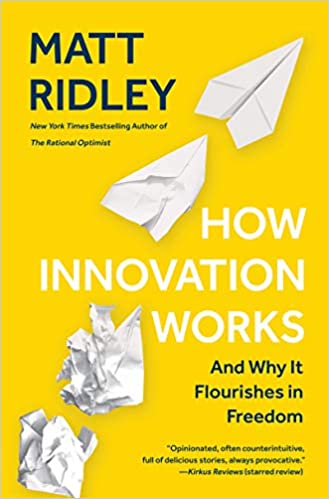You have /5 articles left.
Sign up for a free account or log in.
 How Innovation Works: And Why It Flourishes in Freedom by Matt Ridley
How Innovation Works: And Why It Flourishes in Freedom by Matt Ridley
Published in May 2020
Having co-written a book with “innovation” in its title, I have more than a passing interest in any book that seeks to explain How Innovation Works.
That this book on innovation is written by Matt Ridley, author of The Rational Optimist, one of my favorite books, all but guarantees me as a reader.
Does Ridley’s new book teach us anything about innovation in higher education? Perhaps. But there is a risk that we can read How Innovation Works and learn the wrong lessons about postsecondary progress.
How Innovation Works is structured in two parts. In the first half of the book, Ridley discusses innovation in sectors such as energy, public health, transport and food. In the book’s second half, Ridley develops a theory of innovation.
In an omission that says something about either Ridley or about us, higher education is absent from any examples of innovation. While I certainly believe that we are in the midst of a postsecondary learning innovation renaissance (hence the co-written book), Ridley completely passes over progress in higher education.
How Innovation Works has much to say about topics as diverse as electrical lighting, airplanes, radio, the Haber-Bosch fertilizer process, corrugated sheet metal, the toilet and wheeled suitcases. How Innovation Works has nothing to say about online, blended or active learning or any other trend or technology in higher education.
What readers interested in academic innovation can take way from How Innovation Works is a definition of innovation that stresses perspiration over inspiration. Ridley is clear that true innovation is a team sport, and rather than proceeding in giant leaps, innovation tends to result from resiliency and long-term efforts.
If we want to make advances in higher education that have both impact and scale, we need to try many different things, fail often and keep going. There is no technological silver bullet to challenges related to access, quality or costs.
Where How Innovation Works fails the higher education reader (and maybe all readers) is in Ridley’s theory of how innovation happens.
For Ridley, innovation requires that government mostly get out of the way. Libertarian thinking, however, only gets one so far if the goal is to make big changes. How Innovation Works completely discounts the role of government in innovations as diverse as the transistor, the laser, the internet or the smartphone -- none of which would have been possible without the underlying basic research funded by public dollars.
Anyone interested in innovation in the U.S. should be worried about public disinvestment in public colleges and universities. These institutions are the source of both the human capital and the basic research that society depends on to advance.
While I disagree with much of what Ridley has to say politically, I appreciate his perspective on the future (positive) and his skills as a writer (envy-inducing).
I’m also in full agreement with Ridley that “innovation is the child of freedom and the parent of prosperity.”
While How Innovation Works is not about higher education, the book provides much inspiration for anyone committed to pushing past the postsecondary status quo.
What are you reading?




